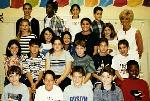
Jim Gilbert
Home Page
Challenge Questions

Today's News

Spring's Journey
North

Report Your Sightings

Teacher's Manual

Search Journey North
return to:

 A/CPB
A/CPB
Tracking Changes in Photoperiod Around the Globe
Mystery Class Update: March 6, 1998
| Mrs. Berger's 5th Grade Class |
(This week's sunrise/sunset times are provided at the end of this report).
Before we get to those times, though, we want to first take care of Challenge
Question # 1 from last week, where we asked you to think about a food web and answer
this:
"How do seasonal changes in photoperiod affect your animal's food web?"
Students in Mrs. Dwyer's 5th Grade Class have been researching robin behavior, and
responded with an answer that does a nice job of showing how seasonal changes in
photoperiod affect the food web for the robin. As a class, read their thoughts and
discuss their conclusions:
"Robins are affected by the seasonal changes in the photoperiod. Some of these
changes are related to the arrival of spring - more sunlight, warmer air, ice melting,
water becoming available, worms and insects becoming active when their food becomes
available (fruits, soil nutrients, other insects, nectar)."
Mrs. Dwyer's 5th Grade Class
Surry Elementary School
Surry, ME 04684
jdwyer@surryes.u92.k12.me.us
|
|
|
Example of Webbing Activity |
On the other hand, the shorter the photoperiod, such as in fall and winter, the
less food that will be available. The reduced amount of sunlight and heat means fewer
plants are available for plant-eating animals, and fewer worms, insects and fish
too, and therefore less food is available for animals that prey on these food sources.
Now, back to this week's sunrise and sunset times from Mrs. Berger's class.
Remember, this information was recorded on Monday, the same day you collected your sunrise/sunset data
Here Are This Week's Data:
Journey North Mystery Class
Sunrise/Sunset Data
Data For: Monday, March 2, 1998
|
Mystery Class |
Sunrise |
Sunset |
|
# 1 |
6:41 |
19:29 |
|
# 2 |
6:52 |
18:06 |
|
# 3 |
5:39 |
22:45 |
|
# 4 |
7:05 |
18:12 |
|
# 5 |
7:02 |
20:04 |
|
# 6 |
7:08 |
18:09 |
|
# 7 |
6:44 |
18:27 |
|
# 8 |
5:55 |
18:21 |
|
# 9 |
7:14 |
19:19 |
|
# 10 |
7:52 |
17:30 |
The Next Mystery Class Update Will be Posted: March 13, 1998
Copyright 1998 Journey North. All Rights Reserved.


